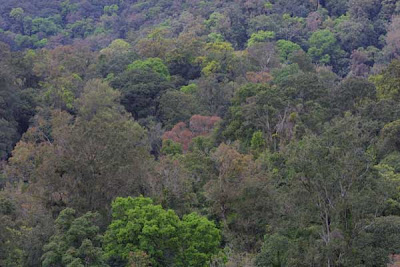
Gunung Salak is a volcano located on the island of Java, Indonesia. Mountain has some of the peak, of which Peak Salak Salak I and II. Geography of the mountain is at 6 ° 43 'LS and 106 ° 44' BT. Highest peak I Salak Salak 2211 m and 2180 m dpl II. There one more peak called Peak Sumbul with a height of 1926 m dpl.
Administratively, G. Salak area included in Sukabumi and Bogor Regency, West Java. Management of the forest area under the Perum Perhutani KPH Bogor, but since 2003 a regional expansion Halimun Mountain National Park, now called National Park of Mount Salak-Halimun.
Vulkanologi and geology
Gunung Salak volcano is a strato type A. Since the year 1600 recorded an explosion occurred several times, including a series of explosion between 1668-1699, 1780, 1902-1903, and 1935. Last eruption occurred in 1938, in the form erupsi freatik that occurred in the crater Cikuluwung Putri.
According to Hartman (1938) G. Salak I was part of the oldest mountains. Followed by G. Salak II and later appeared G. Sumbul. Craters while the Queen is a product of the end of the G. Salak. Putri Cikuluwung craters and craters Hirup is still a part of the crater of Queen.
Climbing routes
Gunung Salak didaki can climb out of some routes. Peak that is most often didaki peak II and I. The most crowded routes is through Curug Nangka, on the north side of the mountain. Through this path, people will reach the peak of Salak II.
I usually peak Salak didaki from the east, near the Cimelati Cicurug. Salak I can also be achieved from the Salak II, and with much difficulty, from Sukamantri, Ciapus.
Other path is the 'back roads' through Cidahu, Sukabumi, or from a crater near the Queen G. Bunder. 
In addition, the Mount Salak more popular as a place where education clubs for lovers of nature, especially once the punggungan Salak II. This is because medan forests of the meeting and also rare climber who visit this mountain. Also has a path that is quite difficult for the beginner climber routes that pass because we rarely find the backup of water in the post unless I upgrade path Ratu crater, at the peak of Mount lucky (2211Mdpl) found wallow air.Gunung eyes Salak mountain, even if classified as a low, akan but both have their unique characteristics and forest medannya.
Nappe forest
Forest-forest in the Gunung Salak consists of mountainous forest down (submontane forest) and forest on the mountain (montane forest).
The lower part of the forest, the forest is planted production Perum Perhutani. Some types of trees that are planted here tusam (Pinus merkusii) and Rasamala (Altingia excelsa). Then, as usually in the bottom of the mountain forest Java, there is also the kind of tree flower (Schima wallichii), Saninten
(Castanopsis sp.), Pairs (Lithocarpus sp.) And various types of hurly (tribe Lauraceae).
In this forest, in some locations, especially in the direction Cidahu, Sukabumi, also found a rare plant species raflesia (Rafflesia rochussenii) that limited the spread of Mount Gede and Mount Pangrango nearby.
In the border areas with the forest, or near-near the river, people to plant species kaliandra red (Calliandra calothyrsus), dadap cangkring (Erythrina variegata), african wood (Maesopsis eminii), jeunjing (Paraserianthes falcataria) and various kinds of bamboo .
Wildlife
Variety of wildlife found in the environment of G. Salak, from the frog and toad, reptiles, birds and mammals.
Results of research Nasir DM (2003) from the Department of the Faculty of Forestry IPB ksh, get 11 frog and toad species in the environment of S. Ciapus Leutik, Tamansari Village, Jl. Bogor .
Species is Bufo asper, B. melanostictus, Leptobrachium hasseltii, Fejervarya limnocharis, Huia masonii, Lim
nonectes kuhlii, L. macrodon, L.microdiscus, Rana chalconota, R. erythraea and R. hosii. This result is not yet include the types of tree frogs, and the types of frogs are still other mountains may be found. In Cidahu also recorded the type of horned bangkong (Megophrys montana ) And the flying frog (Rhacophorus reinwardtii).
Different types of reptiles, especially the lizard and snake, there are at gunungini. Some of the examples is vacillator Bronchocela jubata and B. cristatella, garden lizard Mabuya multifasciata
and river biawak Varanus salvator.
Types of snakes in G. Salak is not yet much known, but some were recorded from the snake handles (Calamaria sp.) Constrained small, snail snake (Pareas carinatus)
until the flower python (Python reticulatus) as long as some
meters. 
G. Salak has been known long before as a rich area
birds, as noted by Vorderman (1885). Hoogerwerf (1948) does not get k
urang from 232 birds in the mountains
This (Java total: 494 species, 368 types of settler). Some of the important mountain is bred eagle (Spizaetus bartelsi) and several other types of eagle, forest red-chicken (Gallus gallus), Cuculus micropterus, Phaenicophaeus javanicus and P. curvirostris, Sasia Abnormis, D
icrurus remifer, Cissa thalassina, Crypsirina temia, bird horse Garrulax rufifrons, Hypothymis azurea, Aethopyga eximia and A. mystacalis, and Lophozosterops javanica.
As well as reptiles and frogs, notes mengenaimamalia G. Salak is not too much. However, in the mountains is clearly found some kind of important, such as spotted tiger (Panthera pardus), owa jawa (Hylobates moloch), lutung surili (Presbytis comata) and anteater (Manis javanica)
Comments